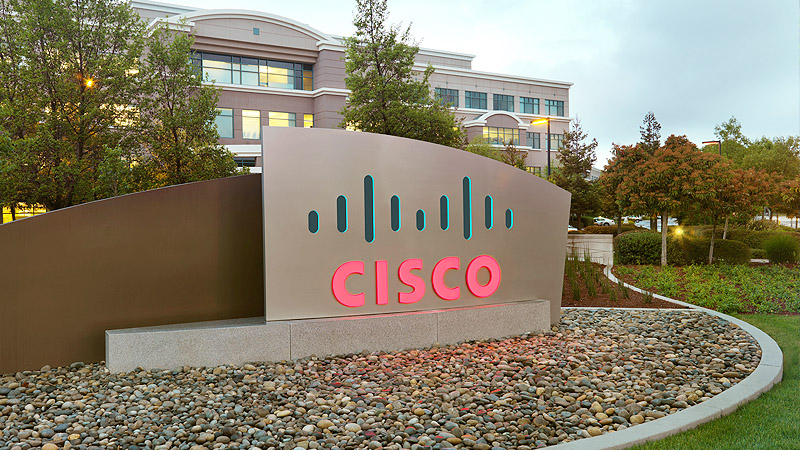TOKYO - March 23, 2009 - Cisco Systems Godo Kaisha (President & CEO: Edzard Overbeek; Address: Akasaka, Minato-ku, Tokyo; Cisco) announced that Kinki Labour Bank (Chairman: Yoshihito Ishibashi; Address: 1-12-1 Edobori, Nishi-ku, Osaka-shi, Osaka; Kinki Rokin) has adopted Cisco products in the network infrastructure of the bank's new headquarters, integrating business systems, unified communications, physical security systems and digital signage.
The new Kinki Rokin building, built near Higobashi in Osaka-shi, has housed around 450 employees since the head office moved in December 2008. The building contains a boardroom, office space, conference rooms and an employee cafeteria. The building has an open design with much use of white walls and glass as a motif, and it has been gaining much attention as a building with presence.
The building was designed by the Information Planning Section of Nikken Sekkei Ltd., which has been implementing the latest information technology in buildings for many years, providing innovative information and telecommunication systems at the cutting edge of social environmental design.
Furthermore, building monitoring systems and control systems for air conditioning and lighting are connected to IP networks. The head office building's network is also connected to branches via a wide-area network, and in common with the head office, these branches are able to use unified communications and information systems.
An integrated network such as this is made possible through the use of Cisco switches and routers offering high reliability and high speed. Two Cisco Catalyst® 6504E switches form the core of the entire network, and they are used as a "single virtual switch" through the use of the Virtual Switching System (VSS). This increases the capacity of a redundant configuration and enables its management using a simple topology.
The deployment of an integrated IP network such as this is expected to provide the following benefits:
1. Smoother communication and cost reduction
In addition to migrating the telephone system to the integrated IP network, the IP phones have wireless local-area network support, making it easier to directly call people not only in the new head office but also in branches. The IP telephones are also linked to the presence system, making it easier for callers to check the status of the other person before calling. As internal calls between offices are also free, communication costs could be significantly reduced.
2. Improved information security
By establishing a network infrastructure boasting high reliability and high speed, it was possible to deploy thin clients for business systems. Because the need to keep data on terminals is eliminated by using thin clients, the security risk of information leaks can be better controlled. With regard to the printout of information, "secure printing" linked with employees' IC cards has already been implemented.
3. Strengthened physical security in the building
Surveillance cameras, IC card readers, biometric authentication and various sensors are integrated into the IP network, enabling them to be linked in a building security system. For example, IC card readers with anti-passback functions are used for room and building access, and the IC card must also be read when leaving the room. Furthermore, by linking human-reacting sensors, alerts are sent to the security guards' room if someone is present when nobody should be present. Video data from surveillance cameras is also stored on a server via the IP network, enabling the efficient management of large quantities of data.
4. Promotion of energy saving
By checking "human presence" with IC card readers and human-reacting sensors, it is possible to automatically control lighting and air conditioning in rooms, limiting unnecessary power consumption. Human-reacting sensors are also installed in corridors and restrooms, automatically turning lights on and off according to human movement. A touch panel facility control is installed at the entrance of the room, displaying the "energy-saving level" according to the status of lighting, air conditioning, natural ventilation and blinds.
5. Increased efficiency in operations
With the deployment of this integrated IP network, business systems are also being upgraded. Such efforts rely on a network infrastructure with high reliability and high speed.
6. Increased building value
Integrating not only the IT systems but also the telephone systems, security systems and building facility management into the IP network has sustained the value of the building, which is expected to rise. The integrated IP network created here can be used for a diverse range of purposes and has been recognized as providing greater return on investment the more it is used.
The six concepts below were also followed from the planning phase of the new Kinki Rokin head office, and the building structure and facilities have been implemented using a multifaceted approach.
- Harmony for humans
- Harmony for ecology
- Harmony for efficiency
- Symbol of Rokin
- Spirit of hospitality
- Safety and trust
For example, the wall surfaces are double-skin, using two layers of glass, saving energy by creating air space between the glass. The offices are wide-span spaces without pillars, enabling the use of a flexible and open layout. The building also features ergonomic design, barrier-free environments, advanced quake-proof design and various security systems.
Cisco advocates Connected Real Estate (CRE) solutions for improving building operation efficiency and increasing real estate value by providing IP networks as a "utility" such as water, electricity and gas. The integrated IP network in Kinki Rokin is also based on the CRE solution, and Cisco is confident that expanding such moves to other buildings will reduce the operating costs of real estate, while making buildings greener, more intelligent and safer.
About Kinki Labour Bank
Kinki Labour Bank (Kinki Rokin) is a workers' credit union operating in the 6 prefectures of Osaka, Kyoto, Hyogo, Nara, Shiga and Wakayama, which was formed when the seven workers' credit unions in the Kinki area merged in 1998. It provides familiar and convenient services to working people under the catch copy of "a financial institution not out to make money." It thoroughly implements non-profit and sound management principles as a "lifestyle and welfare financial institution" primarily targeting working people. The new head office was completed and the head office sales department began operations in October 2008, the year that marked the 10th anniversary of the merger. The bank is actively developing new business models while thoroughly implementing a "customer-centric" approach. See the following web site for further details and an overview of Kinki Rokin. http://www.rokin.or.jp/



